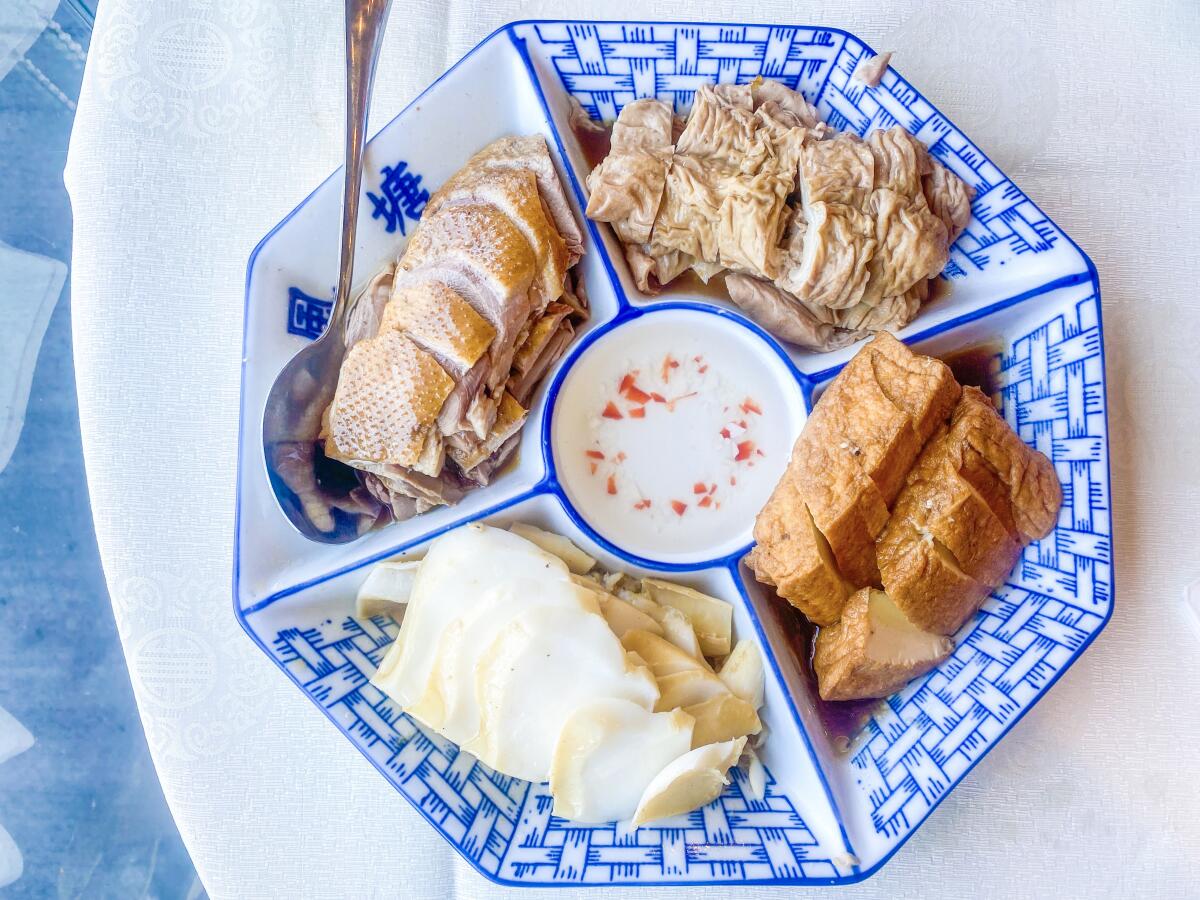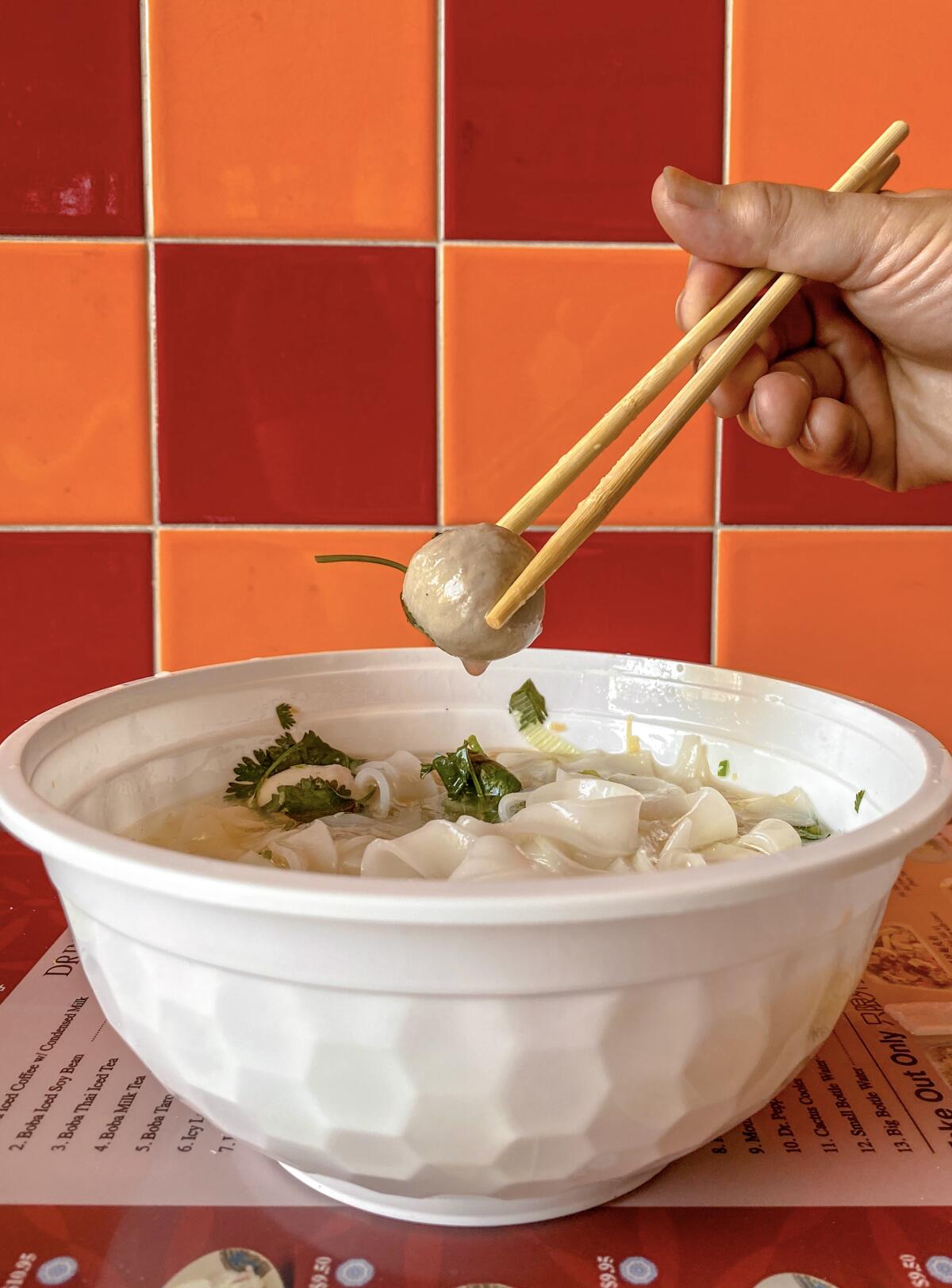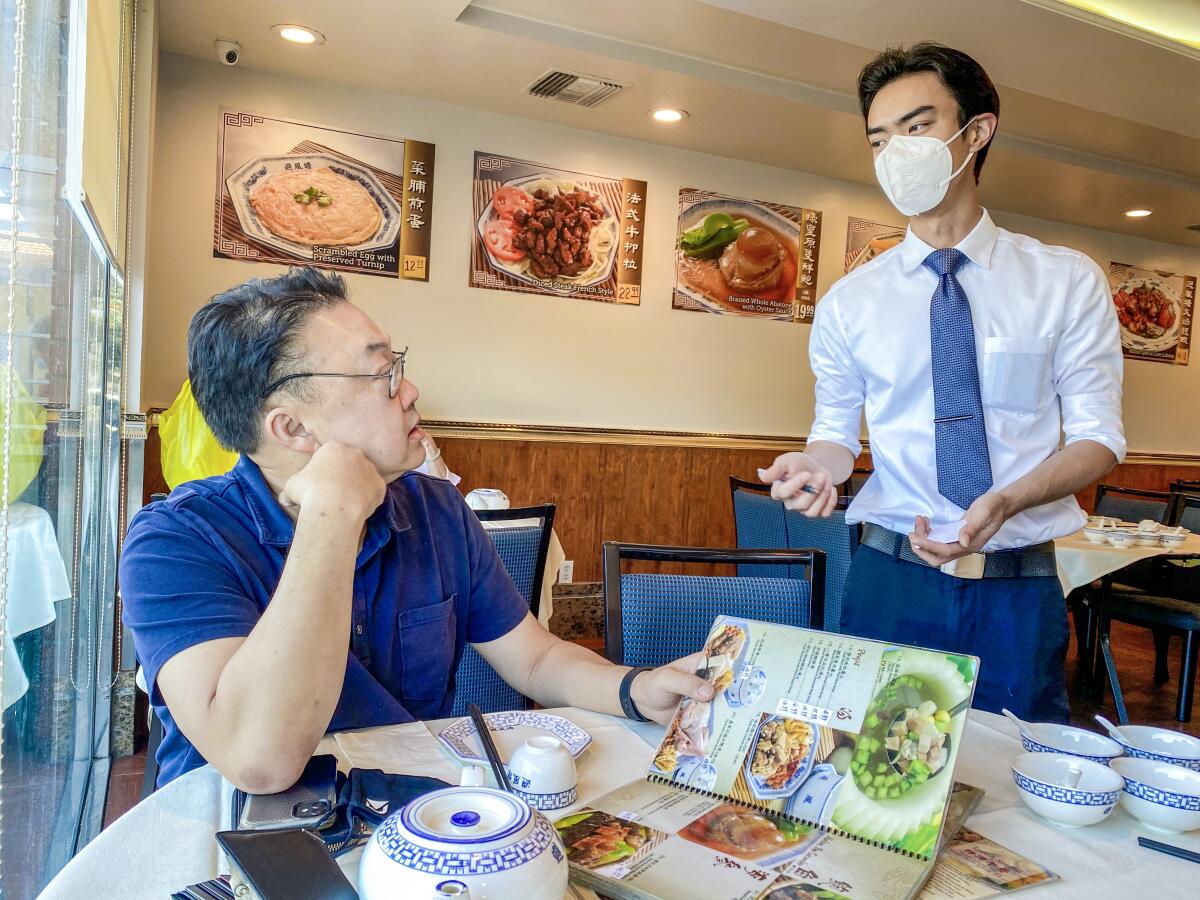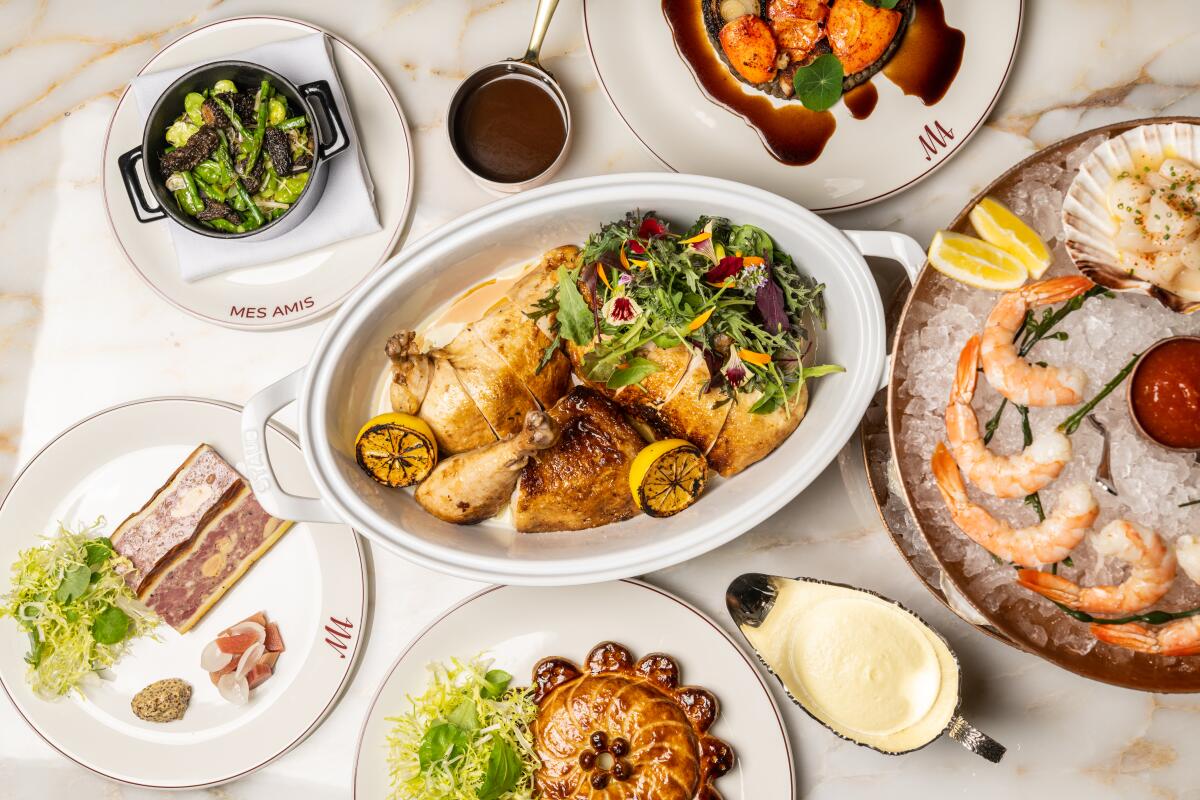Diving into the wonders of Chiu Chow cooking in L.A.

“I went for a chicken sandwich at Daybird, had breakfast at Destroyer, and swung by United Bakery and Pastry on a recommendation from a friend,” Lee F. Man was telling me.
Man lives in Vancouver and was visiting Los Angeles over the weekend. He writes about the wealth of Chinese restaurants in British Columbia; we met in 2017 while I was reporting for Eater on the singular Cantonese dining culture in Vancouver and Richmond in the Canadian province. Earlier this week, we were plotting lunch while he was in L.A., and he was giving me a rundown of his eating itinerary.
“I had to try the Hainan chicken at Pearl River Deli’s new location,” Man continued. “And then [Pearl River Deli chef-owner] Johnny Lee mentioned Kim Ky, his favorite comfort-food place for Chiu Chow noodles in the SGV, so I went there and …”
“Hold up,” I said. “Tell me more about that.”
Enjoying this newsletter? Consider subscribing to the Los Angeles Times
Your support helps us deliver the news that matters most. Become a subscriber.
I remembered the brief primer Man had given me on Chiu Chow cooking in Vancouver. Alternately spelled Chaozhou or Teochew, the name refers both to a city in China’s Guangdong province about 180 miles northeast of Hong Kong and to a distinct regional cuisine. A condensed list of Chiu Chow specialties includes chilled crab, oyster omelet, braised meats (including goose and duck), noodle soups in clear broths and dishes punctuated with preserved vegetables and seafood.
Over distant centuries and recent decades, its people and their foodways have migrated to Southeast Asia and beyond; a global diaspora maintains culinary traditions that also at times convey mingled influences.
“Let’s go eat Chiu Chow food,” I said to Man.
Our first stop was Kim Chuy in Chinatown’s Far East Plaza. The restaurant — currently operating as a takeout window, with customers eating meals at tables set up around the mall’s courtyard — is run by the Lim family. They fled Cambodia in 1979 to escape the genocidal reign of the Khmer Rouge. Their menu reflects Chiu Chow cooking in the context of noodles, porridges and street-food snacks. Man, who was born in Hong Kong, quizzed the staff in Cantonese while ordering for us.
Eat your way across L.A.
Get our weekly Tasting Notes newsletter for reviews, news and more.
You may occasionally receive promotional content from the Los Angeles Times.
First up: pan-fried cakes filled with snipped Chinese leeks, also known as garlic chives. The rice flour dough had a consistency similar to mochi, satisfyingly soft and stretchy under the crisped brown exterior. Fish cakes were fried to a coppery color and served with pickled vegetables; the texture was correctly bouncy, a sign the kitchen made them from scratch. Man pointed out the sweet, rich dipping sauce that came on the side. “This is an example of the Southeast Asian influence,” he said. “In Guangdong, the sauce would lean more vinegary.”

Next came two typical Chiu Chow soups served with flat, wide rice noodles. One was dotted with balls of ground fish, also properly springy, in a clear stock with a faint echo of seafood. The other was ruddy beef satay with big, complex flavors: peanut, garlic, chile and harder-to-pinpoint flavors from Shacha sauce, a condiment that usually includes dried shrimp and brill. Two very different and equally gratifying bowls worth slurping through. And again, the condiments for the soup — similar to the sauces you’d add to pho, including hoisin — reminded Man of the family’s connection to Cambodia.
Lu wei is the term for various meats braised in a mixture of soy sauce, stock and aromatic spices that’s often called a “master sauce” in English. Man ordered duck prepared this way; the meat and skin, united into near-uniform tenderness, had deeply absorbed the fragrance of star anise.
It was a noteworthy contrast to the duck prepared in the lu wei method at our next stop, Seafood Palace in Monterey Park. Formerly known as Seafood Village, this is arguably the best known restaurant for Chiu Chow dishes in Los Angeles. Its cooking reflects an urbanized expression of the cooking that evolved during the 1950s in Hong Kong when mainland China opened its borders.
“In Hong Kong, Chiu Chow food is for rich people,” said Man. “The city version, like rustic provincial French cooking adapting to tastes in Paris, is often made with expensive dried seafood.”
The most famous dish at Seafood Palace is the house-special crab battered, fried and blitzed with crackling bits of fried garlic. It’s a riff on a Cantonese dish known as “typhoon shelter” crab, and we noticed nearly tables ordered it.
“That’s not Chiu Chow,” said Man. For a dish in a truer style, call the restaurant a day ahead to reserve cold crab served with a nuanced sauce, made to order, with a clear note of dried kumquat.

We began our meal with an appetizer combination of four cold lu wei preparations: pale, delicate slices of cuttlefish; sliced duck in which the spices were far more of a whisper than a bray; pork intestines with a wonderful crinkled texture; and custardy deep-fried tofu that had nicely soaked in the soy oomph of the master sauce. The dipping sauce in the center was the clear, vinegary variety, with a bit of red chile and garlic. Its sharpness teased out the presence of the spices in the dishes.
The restaurant’s version of the famous Chiu Chow oyster omelet had the requisite springiness. Gai lan stir-fried with bits of dried fish was off the mark that day; the vegetable had been overcooked and the fish veered chewy when, Man sighed, it should have been more chewy-crisp. (These distinctions are important.) By far the most satisfying dish was the “Chiu Chow special porridge” — whole grains of rice simmered in a clear, seafood-tinged broth with oysters, dried shrimp and salty exclamation points of preserved vegetables.
As he ladled a second helping of the porridge for us, Man considered the restaurant experiences. “The specificity of the Chiu Chow-Cambodian flavors at Kim Chuy? I don’t see them in Vancouver. They reflected a family’s journey. That was a real Southern California experience. And the combination of styles at Seafood Palace — yes, it’s sad that pure Cantonese cooking is disappearing, but the evolution of the menus, the Chiu Chow cooking mixed with Hong Kong dishes and other mainland dishes [kung pao scallops as one example] is still fascinating. If this was home, I’d come to the places all the time.”
I listened and nodded and, for the thousandth time, felt the unique sense of possibility that living in Los Angeles can bring.
Have a question?
Other stories
— Moving the focus to a dish that originates from the Sichuan province: Lucas Kwan Peterson names his favorite places to eat mapo tofu.
— Jenn Harris, Stephanie Breijo and Lucas joined forces to call out the 14 best places to pick up a picnic to enjoy at the Hollywood Bowl. And Julie Giuffrida has your picnic-packing strategy if you’re assembling the meal at home.
— Jenn reports on Chinese and Korean chefs in Los Angeles who are worried that a ban on future gas stoves may alter their kitchens forever.
— She also has tips on eating all the pizzas, pupusas and gumbo at Blvd Mrkt in Montebello.
— Stephanie has a story on the surprise reopening of Tamales Elena y Antojitos. (I would have been very sad to never have a bowl of the restaurant’s pozole verde again.)
— Finally, Brasserie Mes Amis debuts, and other restaurant news of the week from Stephanie.

Eat your way across L.A.
Get our weekly Tasting Notes newsletter for reviews, news and more.
You may occasionally receive promotional content from the Los Angeles Times.



